remote start PONTIAC VIBE 2009 Owners Manual
[x] Cancel search | Manufacturer: PONTIAC, Model Year: 2009, Model line: VIBE, Model: PONTIAC VIBE 2009Pages: 318, PDF Size: 1.53 MB
Page 69 of 318

Arming the System
To arm the system:
1. Close all the doors and the
liftgate.
2. Lock the doors and liftgate with
the key or Remote Keyless
Entry (RKE) transmitter.
The security light comes on solid.
The system automatically arms
after 30 seconds. The security
light �ashes when the system
is armed.
No one should be in the vehicle
when the alarm system is armed
because unlocking the vehicle from
the inside activates the system.
To avoid setting off the alarm make
sure all passengers are out of
the vehicle and the windows are
closed before arming the system.
Disarming the System
To disarm the alarm do one of the
following:
Unlock the doors with the key.
Unlock the doors and liftgate with
the RKE transmitter.
Start the engine.
Testing the Alarm
To test the alarm:
1. Open all the windows.
2. Set the system as described
in the previous procedure.
The doors and liftgate should
be locked with the key or RKE
transmitter. Be sure to wait until
the security light starts �ashing.
3. Unlock the driver door from the
inside. The system should
activate the alarm.
4. Stop the alarm as described in
the disarming procedure.
5. Repeat this operation for the
other doors. Also, check that
the system is activated when the
battery terminal is disconnected
and then reconnected.If the system does not work
properly, have it checked by your
dealer/retailer.
How the System Alarm is
Activated
The system activates the alarm if:
A locked door or the liftgate is
unlocked or opened without the
RKE transmitter.
A locked door is unlocked or
opened without the key.
The liftgate is unlocked or opened
with the key.
The battery is reconnected.
The side windows are tapped or
broken.
Do not leave the key or device that
disarms or deactivates the theft
deterrent system in the vehicle.
Keys, Doors and Windows 2-11
2009 - Pontiac Vibe Owner Manual
Page 179 of 318
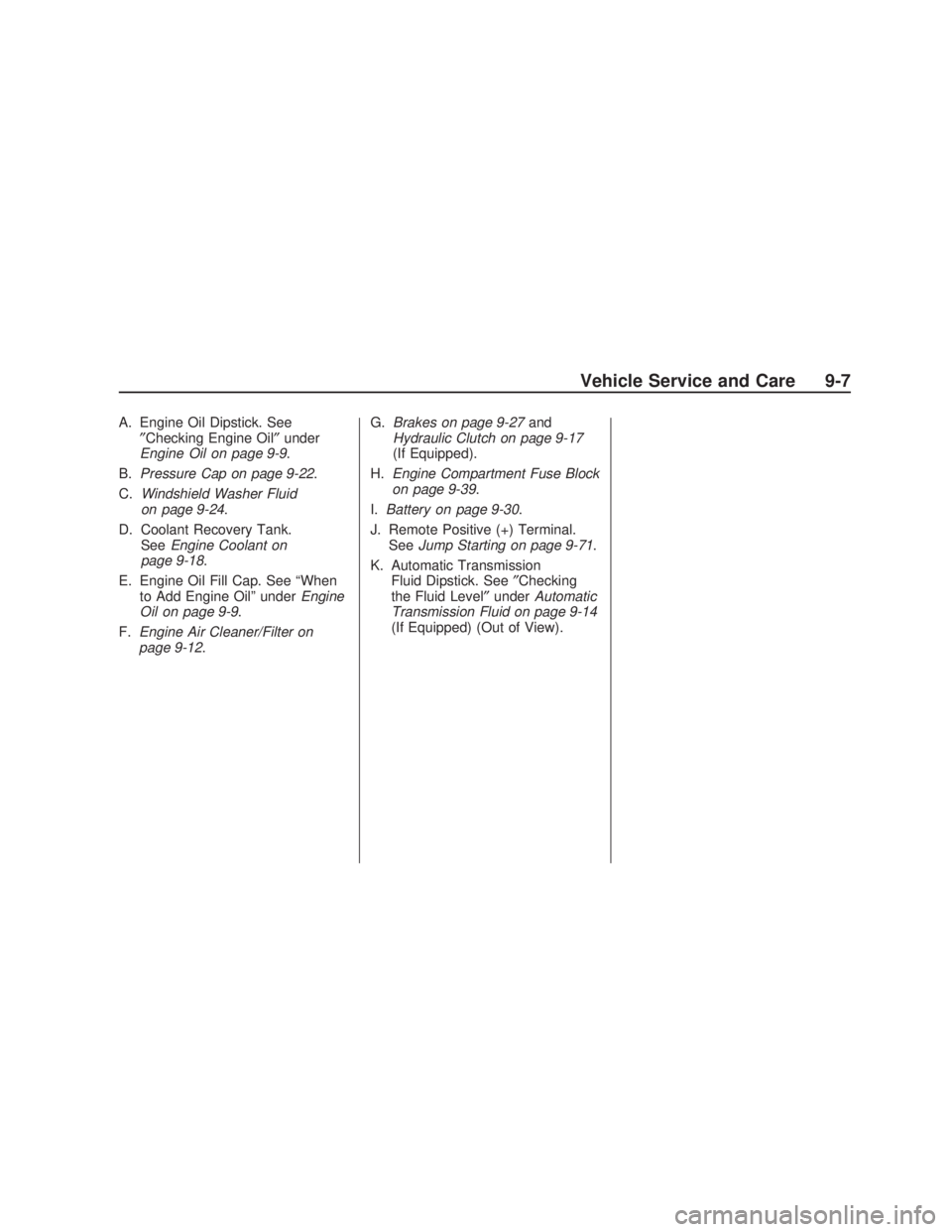
A. Engine Oil Dipstick. See
″Checking Engine Oil″under
Engine Oil on page 9-9.
B.Pressure Cap on page 9-22.
C.Windshield Washer Fluid
on page 9-24.
D. Coolant Recovery Tank.
SeeEngine Coolant on
page 9-18.
E. Engine Oil Fill Cap. See “When
to Add Engine Oil” underEngine
Oil on page 9-9.
F.Engine Air Cleaner/Filter on
page 9-12.G.Brakes on page 9-27and
Hydraulic Clutch on page 9-17
(If Equipped).
H.Engine Compartment Fuse Block
on page 9-39.
I.Battery on page 9-30.
J. Remote Positive (+) Terminal.
SeeJump Starting on page 9-71.
K. Automatic Transmission
Fluid Dipstick. See″Checking
the Fluid Level″underAutomatic
Transmission Fluid on page 9-14
(If Equipped) (Out of View).
Vehicle Service and Care 9-7
2009 - Pontiac Vibe Owner Manual
Page 181 of 318
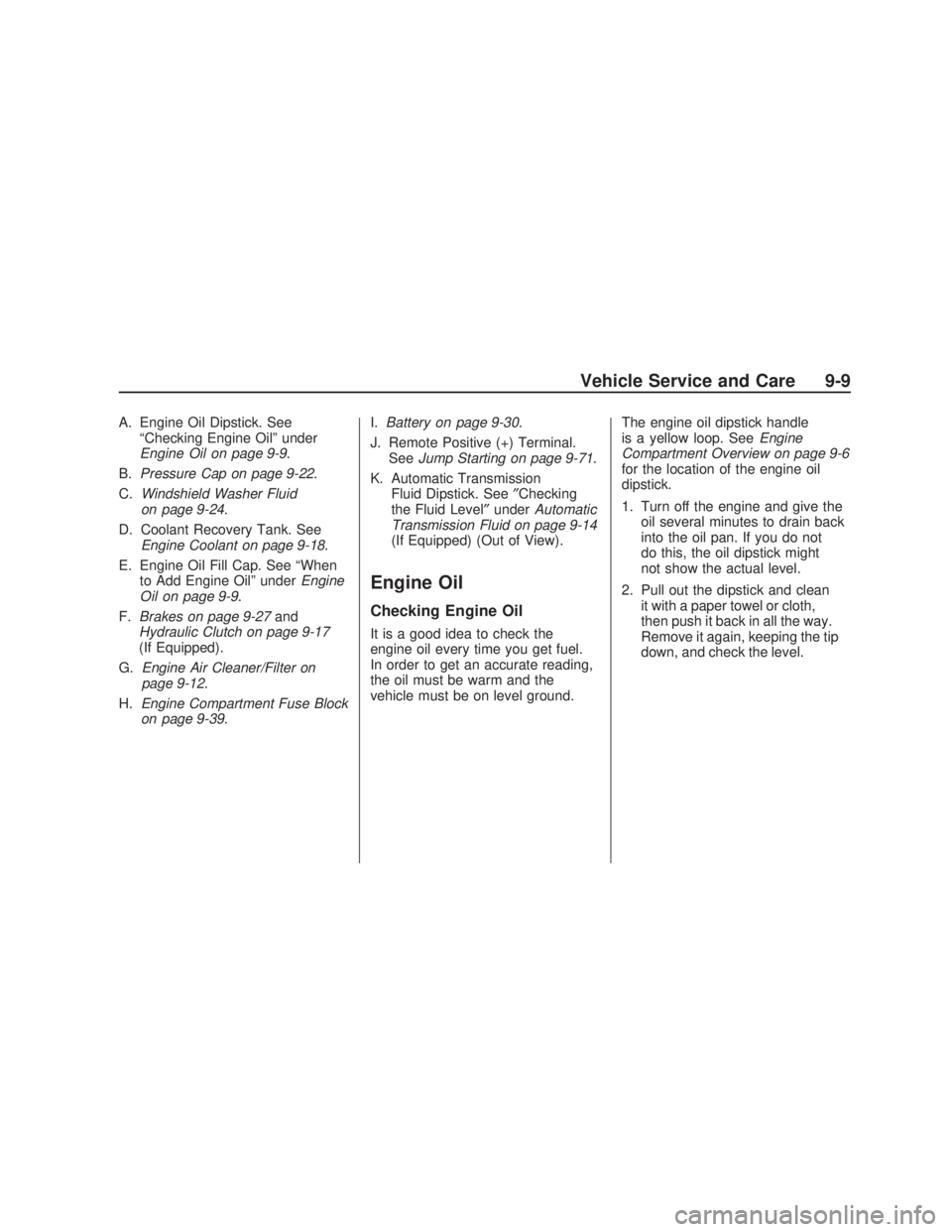
A. Engine Oil Dipstick. See
“Checking Engine Oil” under
Engine Oil on page 9-9.
B.Pressure Cap on page 9-22.
C.Windshield Washer Fluid
on page 9-24.
D. Coolant Recovery Tank. See
Engine Coolant on page 9-18.
E. Engine Oil Fill Cap. See “When
to Add Engine Oil” underEngine
Oil on page 9-9.
F.Brakes on page 9-27and
Hydraulic Clutch on page 9-17
(If Equipped).
G.Engine Air Cleaner/Filter on
page 9-12.
H.Engine Compartment Fuse Block
on page 9-39.I.Battery on page 9-30.
J. Remote Positive (+) Terminal.
SeeJump Starting on page 9-71.
K. Automatic Transmission
Fluid Dipstick. See″Checking
the Fluid Level″underAutomatic
Transmission Fluid on page 9-14
(If Equipped) (Out of View).
Engine Oil
Checking Engine Oil
It is a good idea to check the
engine oil every time you get fuel.
In order to get an accurate reading,
the oil must be warm and the
vehicle must be on level ground.The engine oil dipstick handle
is a yellow loop. SeeEngine
Compartment Overview on page 9-6
for the location of the engine oil
dipstick.
1. Turn off the engine and give the
oil several minutes to drain back
into the oil pan. If you do not
do this, the oil dipstick might
not show the actual level.
2. Pull out the dipstick and clean
it with a paper towel or cloth,
then push it back in all the way.
Remove it again, keeping the tip
down, and check the level.
Vehicle Service and Care 9-9
2009 - Pontiac Vibe Owner Manual
Page 212 of 318
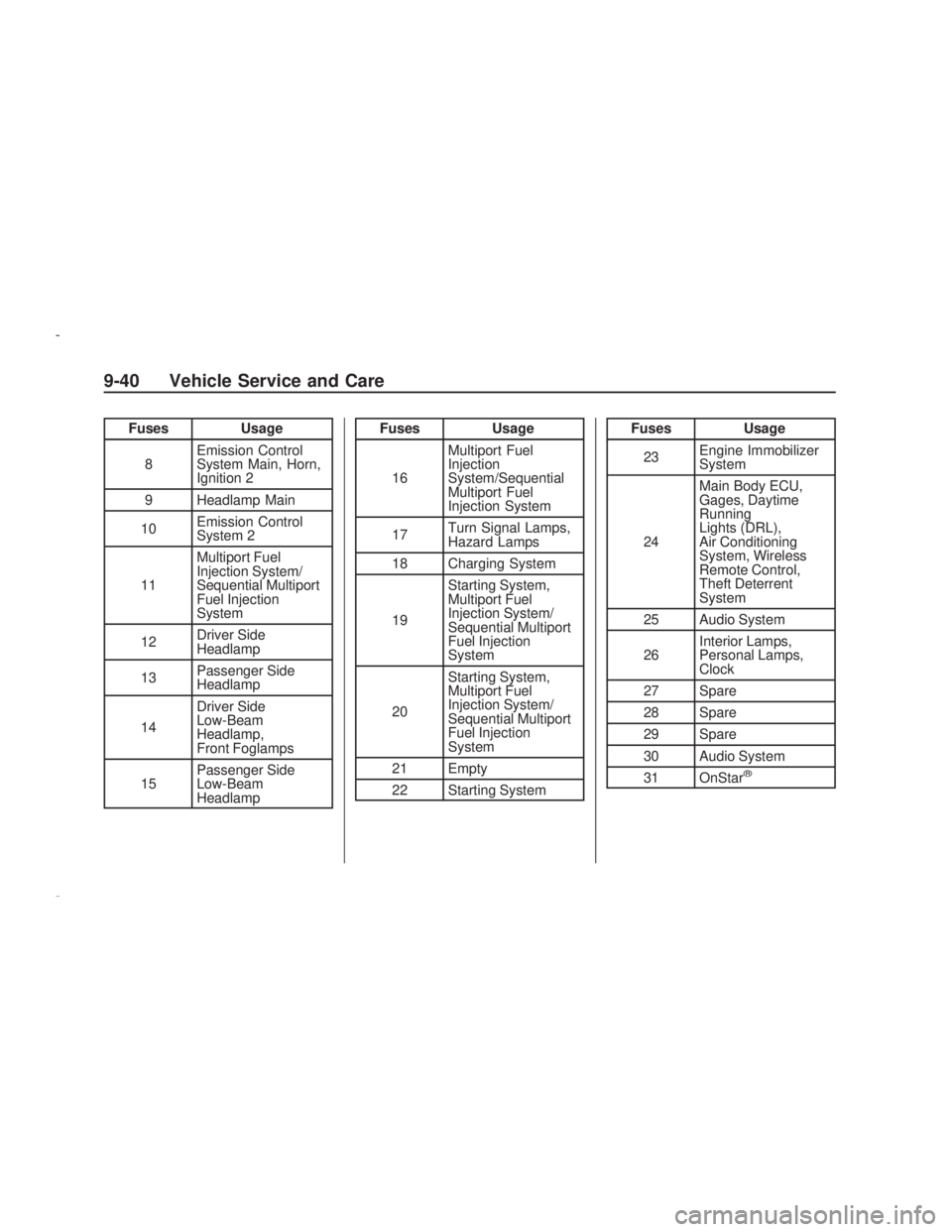
Fuses Usage
8Emission Control
System Main, Horn,
Ignition 2
9 Headlamp Main
10Emission Control
System 2
11Multiport Fuel
Injection System/
Sequential Multiport
Fuel Injection
System
12Driver Side
Headlamp
13Passenger Side
Headlamp
14Driver Side
Low-Beam
Headlamp,
Front Foglamps
15Passenger Side
Low-Beam
HeadlampFuses Usage
16Multiport Fuel
Injection
System/Sequential
Multiport Fuel
Injection System
17Turn Signal Lamps,
Hazard Lamps
18 Charging System
19Starting System,
Multiport Fuel
Injection System/
Sequential Multiport
Fuel Injection
System
20Starting System,
Multiport Fuel
Injection System/
Sequential Multiport
Fuel Injection
System
21 Empty
22 Starting SystemFuses Usage
23Engine Immobilizer
System
24Main Body ECU,
Gages, Daytime
Running
Lights (DRL),
Air Conditioning
System, Wireless
Remote Control,
Theft Deterrent
System
25 Audio System
26Interior Lamps,
Personal Lamps,
Clock
27 Spare
28 Spare
29 Spare
30 Audio System
31 OnStar
®
9-40 Vehicle Service and Care
2009 - Pontiac Vibe Owner Manual
Page 244 of 318
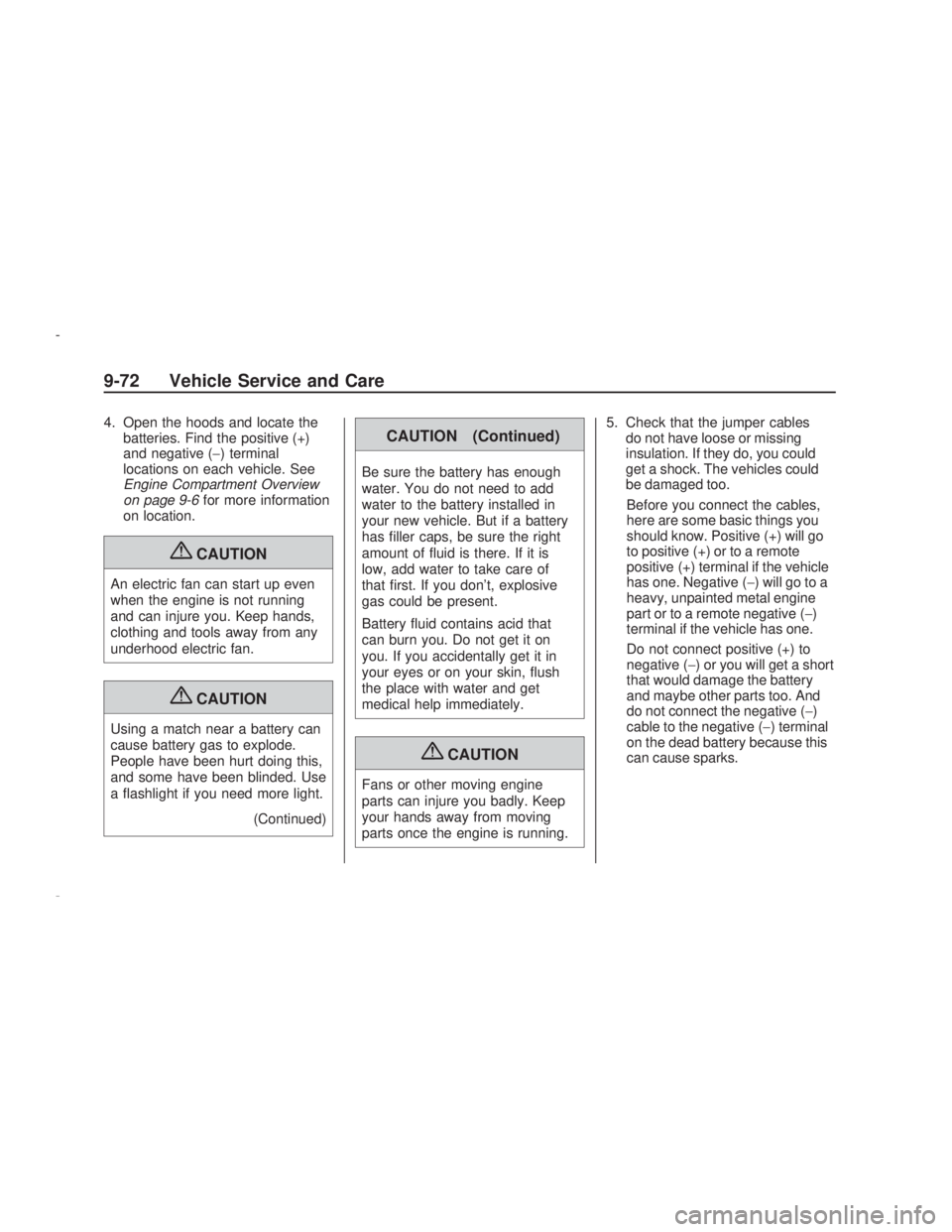
4. Open the hoods and locate the
batteries. Find the positive (+)
and negative (−) terminal
locations on each vehicle. See
Engine Compartment Overview
on page 9-6for more information
on location.
{CAUTION
An electric fan can start up even
when the engine is not running
and can injure you. Keep hands,
clothing and tools away from any
underhood electric fan.
{CAUTION
Using a match near a battery can
cause battery gas to explode.
People have been hurt doing this,
and some have been blinded. Use
a �ashlight if you need more light.
(Continued)
CAUTION (Continued)
Be sure the battery has enough
water. You do not need to add
water to the battery installed in
your new vehicle. But if a battery
has �ller caps, be sure the right
amount of �uid is there. If it is
low, add water to take care of
that �rst. If you don’t, explosive
gas could be present.
Battery �uid contains acid that
can burn you. Do not get it on
you. If you accidentally get it in
your eyes or on your skin, �ush
the place with water and get
medical help immediately.
{CAUTION
Fans or other moving engine
parts can injure you badly. Keep
your hands away from moving
parts once the engine is running.5. Check that the jumper cables
do not have loose or missing
insulation. If they do, you could
get a shock. The vehicles could
be damaged too.
Before you connect the cables,
here are some basic things you
should know. Positive (+) will go
to positive (+) or to a remote
positive (+) terminal if the vehicle
has one. Negative (−) will go to a
heavy, unpainted metal engine
part or to a remote negative (−)
terminal if the vehicle has one.
Do not connect positive (+) to
negative (−) or you will get a short
that would damage the battery
and maybe other parts too. And
do not connect the negative (−)
cable to the negative (−) terminal
on the dead battery because this
can cause sparks.
9-72 Vehicle Service and Care
2009 - Pontiac Vibe Owner Manual
Page 296 of 318
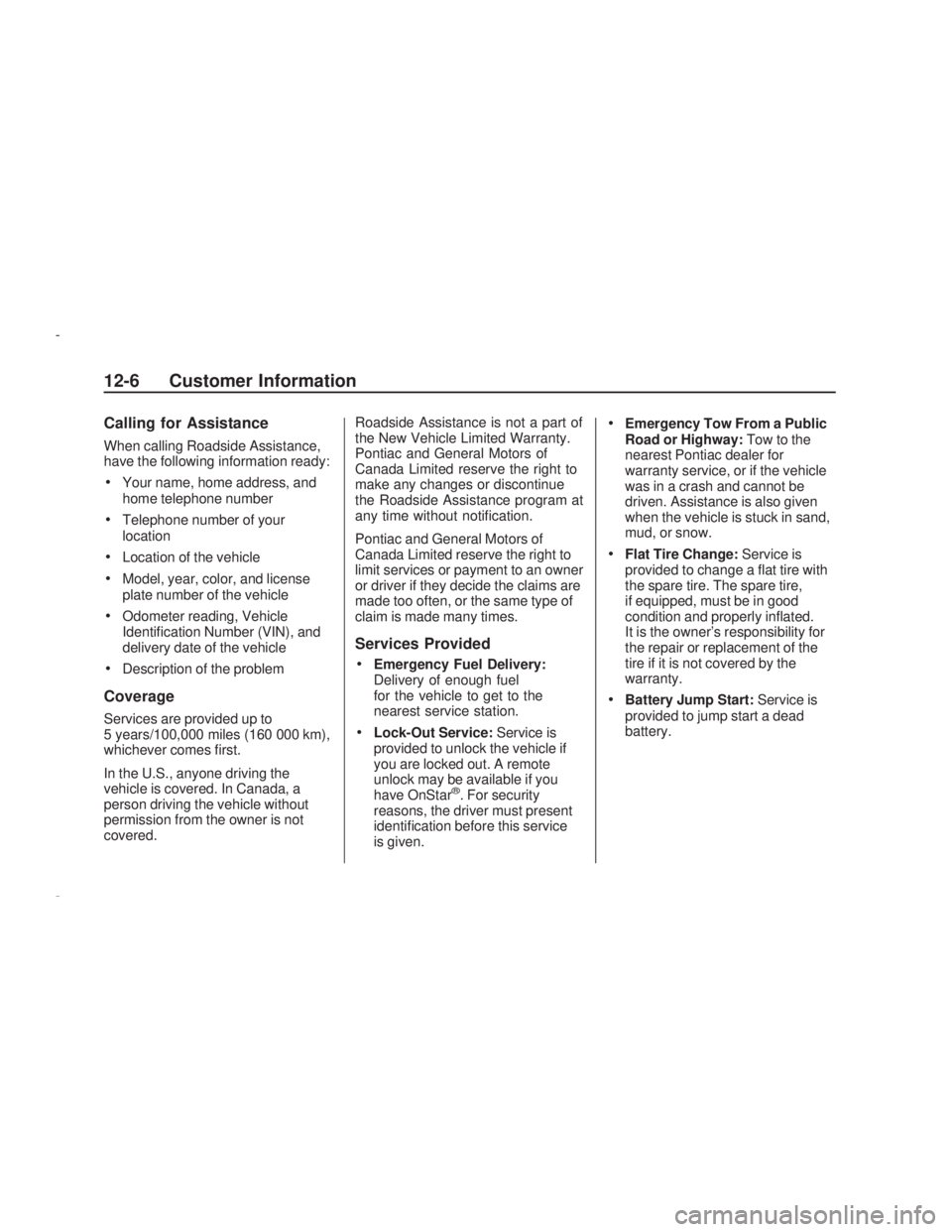
Calling for Assistance
When calling Roadside Assistance,
have the following information ready:
Your name, home address, and
home telephone number
Telephone number of your
location
Location of the vehicle
Model, year, color, and license
plate number of the vehicle
Odometer reading, Vehicle
Identi�cation Number (VIN), and
delivery date of the vehicle
Description of the problem
Coverage
Services are provided up to
5 years/100,000 miles (160 000 km),
whichever comes �rst.
In the U.S., anyone driving the
vehicle is covered. In Canada, a
person driving the vehicle without
permission from the owner is not
covered.Roadside Assistance is not a part of
the New Vehicle Limited Warranty.
Pontiac and General Motors of
Canada Limited reserve the right to
make any changes or discontinue
the Roadside Assistance program at
any time without noti�cation.
Pontiac and General Motors of
Canada Limited reserve the right to
limit services or payment to an owner
or driver if they decide the claims are
made too often, or the same type of
claim is made many times.
Services Provided
Emergency Fuel Delivery:
Delivery of enough fuel
for the vehicle to get to the
nearest service station.
Lock-Out Service:Service is
provided to unlock the vehicle if
you are locked out. A remote
unlock may be available if you
have OnStar
®. For security
reasons, the driver must present
identi�cation before this service
is given.
Emergency Tow From a Public
Road or Highway:Tow to the
nearest Pontiac dealer for
warranty service, or if the vehicle
was in a crash and cannot be
driven. Assistance is also given
when the vehicle is stuck in sand,
mud, or snow.
Flat Tire Change:Service is
provided to change a �at tire with
the spare tire. The spare tire,
if equipped, must be in good
condition and properly in�ated.
It is the owner’s responsibility for
the repair or replacement of the
tire if it is not covered by the
warranty.
Battery Jump Start:Service is
provided to jump start a dead
battery.
12-6 Customer Information
2009 - Pontiac Vibe Owner Manual
Page 308 of 318

This data can help provide a better
understanding of the circumstances
in which crashes and injuries occur.
Important:EDR data is recorded
by your vehicle only if a non-trivial
crash situation occurs; no data
is recorded by the EDR under
normal driving conditions and no
personal data (e.g., name, gender,
age, and crash location) is
recorded. However, other parties,
such as law enforcement, could
combine the EDR data with the type
of personally identifying data
routinely acquired during a crash
investigation.
To read data recorded by an EDR,
special equipment is required,
and access to the vehicle or the
EDR is needed. In addition to
the vehicle manufacturer, other
parties, such as law enforcement,
that have the special equipment, can
read the information if they have
access to the vehicle or the EDR.GM will not access this data or
share it with others except: with the
consent of the vehicle owner or,
if the vehicle is leased, with the
consent of the lessee; in response
to an official request of police or
similar government office; as part of
GM’s defense of litigation through
the discovery process; or, as
required by law. Data that GM
collects or receives may also be
used for GM research needs or may
be made available to others for
research purposes, where a need is
shown and the data is not tied to
a speci�c vehicle or vehicle owner.
OnStar®
If your vehicle has OnStar and you
subscribe to the OnStar services,
please refer to the OnStar Terms and
Conditions for information on data
collection and use.
Navigation System
If your vehicle has a navigation
system, use of the system may result
in the storage of destinations,
addresses, telephone numbers, and
other trip information. Refer to the
navigation system operating manual
for information on stored data and for
deletion instructions.
Radio Frequency
Identi�cation (RFID)
RFID technology is used in some
vehicles for functions such as
tire pressure monitoring and ignition
system security, as well as in
connection with conveniences such
as key fobs for remote door
locking/unlocking and starting, and
in-vehicle transmitters for garage
door openers. RFID technology in
GM vehicles does not use or record
personal information or link with
any other GM system containing
personal information.
12-18 Customer Information
2009 - Pontiac Vibe Owner Manual